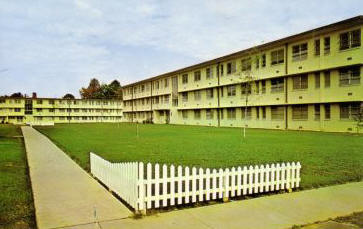| SAC Bases: Columbus
Air Force Base |
|
|
|
Columbus Air
Force Base began as an advanced twin-engine flying school during the
rearming of America prior to World War II. Efforts by local civic leaders
in the 1930s to secure an airport shifted to obtaining a military flying
field as U.S. forces geared up for war. On June 26, 1941, the War
Department announced Columbus’ selection as the site for an Army Air Corps
pilot training school. Construction got under way in 1941, and pilot
training began in 1942.
With an unparalleled safety record, this is where both
instrument training and flying standardization boards got their start,
earning the Columbus Army Flying School national recognition in Time
magazine and the New York Times. More than 8,000 students came to Columbus
for pilot training during World War II to become flying officers in the Army
Air Corps. AT-6s, AT-8s, AT-9s, AT-10s, Lockheed-Hudson A-29s and TB-25s
were used at Columbus during this time. By war’s end the air base, now
known as Columbus Army Air Field, had become one of the largest in the
Southeast, with four runways and seven auxiliary fields
The base was closed in 1945 and remained inactive until
the nation again faced the prospect of war, this time to defend South
Korea. Because post-World War II disarmament had been so extensive, the Air
Force found itself pressed beyond its pilot training limits. The nation’s
pilot production goal more than doubled, to 10,000 annually, necessitating
more training bases.
The crisis impelled the Air Force to turn to
contract pilot training, which could expand capacity quickly and
inexpensively, so Columbus Air Force Base reopened in 1951 as a contract
flying school. Air Training Command’s 3301st Pilot Training Squadron
oversaw the contract flight instruction of about 3,000 pilots in PA-18 Piper
Cubs and T-6s.
With the Korean War at an end and pilot
production needs dropping, the decision was made to close the contract
flying school at Columbus. Though desirable as a start-up school, contract
operations could operate economically only if the student load were at or
near maximum capacity. But while the Air Force’s pilot training
requirements were decreasing, its strategic air arm was expanding. During
the 1950s, Strategic Air Command wings had become extremely large. As the
Russian missile threat became more pronounced and warning time decreased,
Strategic Air Command bases presented increasingly attractive targets. But
by providing additional bases to which the aircraft could be dispersed, the
enemy’s targeting problem would be compounded, and more bombers could become
airborne within a given time period. It was therefore decided to break up
these large concentrations of aircraft and distribute them among more
bases. Thus Columbus Air Force Base was relinquished to the Strategic Air
Command in April 1955.
After a four-year rebuilding program to
prepare the base for its new mission, Columbus became home to a B-52 bomber
squadron and a KC-135 tanker squadron in 1958. Beginning in 1965, the same
year it won the coveted Fairchild Trophy as “Best in SAC,” Columbus’ 454th
Bombardment Wing deployed to the western Pacific, completing more than 100
missions to South Vietnam without losing a single bomber to enemy aircraft
fire.
A convergence of situations brought a close to
the Strategic Air Command years at Columbus. As the demand for pilots to
support the war in Southeast Asia increased, the number of B-52s stateside
fell because they were needed overseas. At the same time, Minuteman and
Polaris missiles were taking their places in strategic deterrence, replacing
much of the bomber alert force. So, after 14 years under Strategic Air
Command, Columbus Air Force Base rejoined Air Training Command July 1, 1969,
and resumed the mission for which it was originally activated—training
pilots. Today Columbus Air Force Base is home to the 14th Flying
Training Wing of Air Education and Training Command’s 19th Air Force.
|
 |
|
